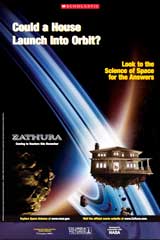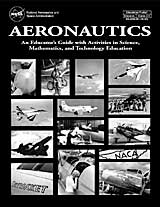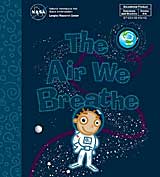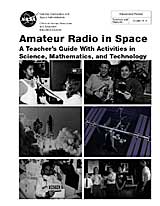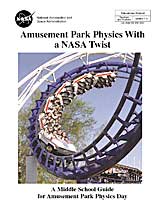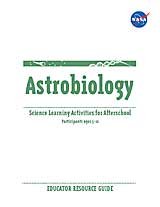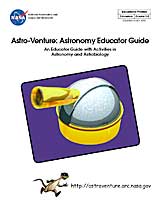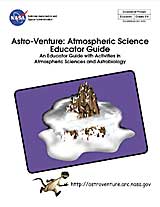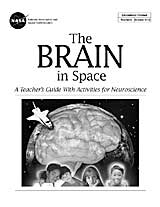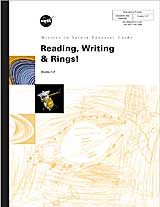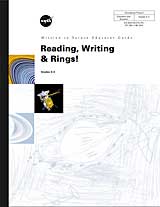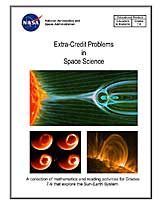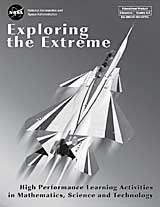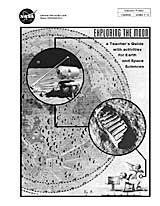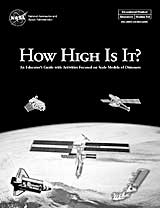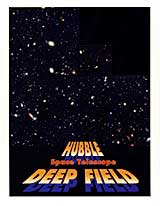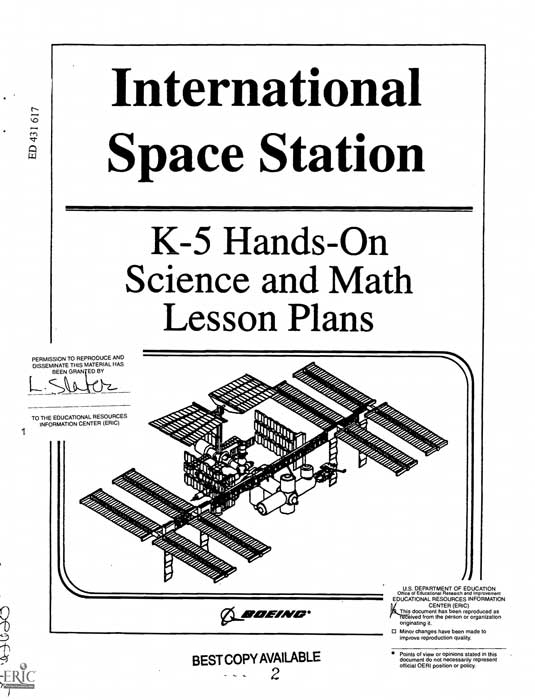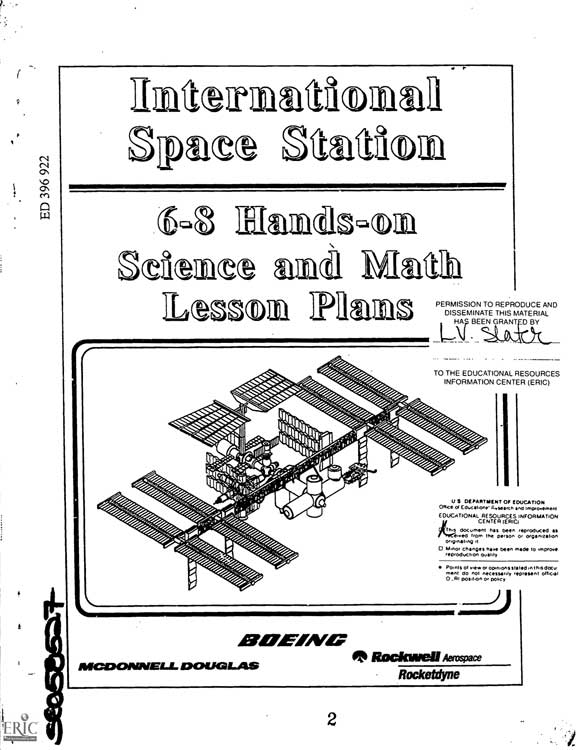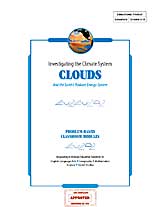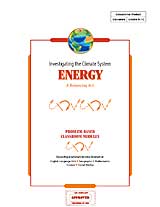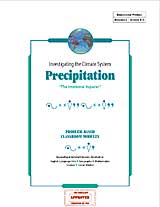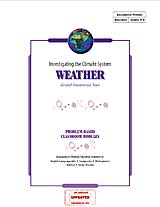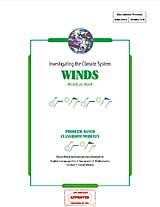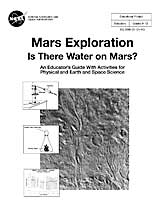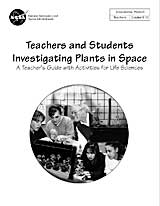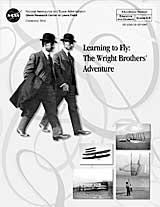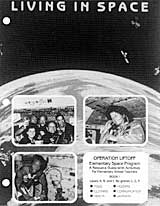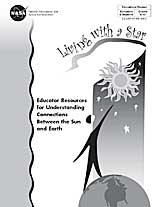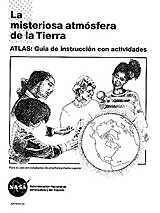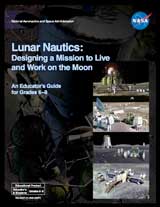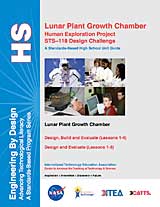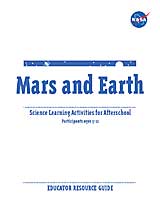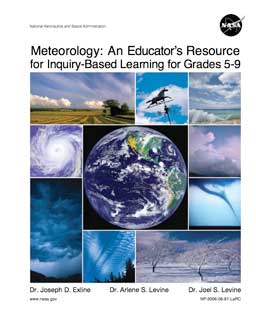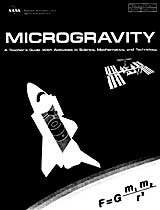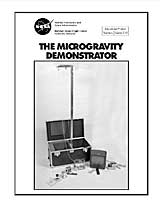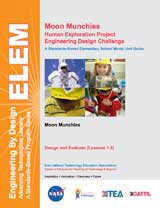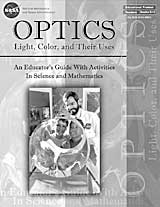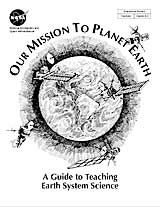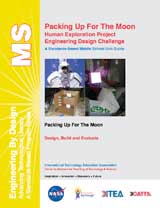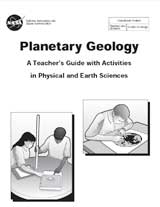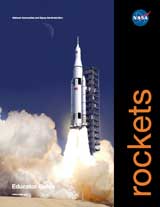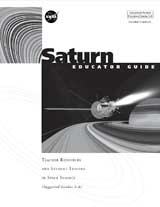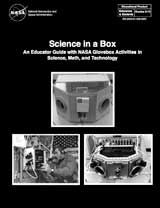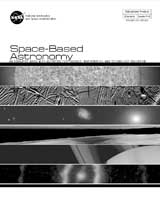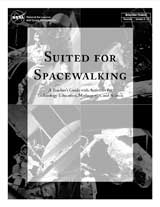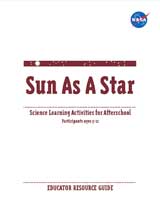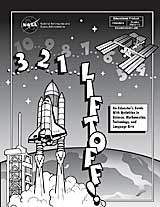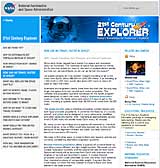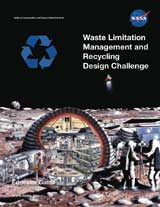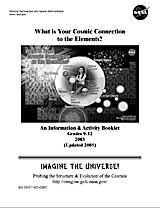Menu (listed alphabetically)
|
Adventure is Waiting - Grades 3-5.Welcome to a dynamic education program to build student skills in both science and language arts. This resource has an activity about Comets, Meteors and Meteoroids. To further explore the universe, check out the Web Quest to learn some amazing things related to the science of space: Gravity, Black Holes and Robots.
The accompanying poster contains easy-to-use, national standards-based lessons and reproducibles for the classroom. There are also inspiring images from the feature film "Zathura", an adventure film based on a children's book by renowned author/illustrator Chris Van Allsburg.
|
|
Aeronautics: An Educator's Guide with Activities in Science, Mathematics, and Technology Education. Grades K-4. EG-2002-06-105-HQ
The activities in this guide help students learn the basic principles of flight. The guide is divided into three chapters:
|
|
The Air We Breathe: "The Air We Breathe" is a picture book designed to introduce Earth's atmosphere and its importance to life on Earth. It also introduces how the introduction of new gases contributes to the changing quality of the air.
|
|
Amateur Radio in Space: A Teacher's Guide with Activities in Science, Mathematics, and Technology. Grades K-4. EG-1998-03-114-HQ
|
|
Amusement Park Physics With a NASA Twist: A Middle School Guide for Amusement Park Physics Day. Grades 7-9. EG-2003-03-010-GRC
|
|
Astrobiology: Science Learning Activities for After School - Educational Product for grades K-8: Astrobiology gives young thinkers the opportunity to explore topics related to the search for life beyond their own planet. As they complete the activities in the guide, students will use some of the same strategies that astrobiologists use. Each of the eight activities takes about one hour to complete.
|
|
Astro-Venture: Astronomy Educator Guide: An Educator Guide with Activities in Astronomy and Astrobiology. Grades 5-8. EG-2002-10-001-ARC
|
|
Astro-Venture: Atmospheric Science Educators Guide: An Educator Guide with Activities in Atmospheric Sciences and Astrobiology. Grades 5-8. EG-2003-02-001-ARC
|
|
The Brain in Space: A Teacher's Guide with Activities in Neuroscience. Grades 5-12 EG-1998-03-118-HQ
|
|
Cassini Huygens: Reading, Writing and Rings - Grades 1 & 2 - EG-2004-03-012-JPL: The lessons in this series provide opportunities for students in grades 1 and 2 to develop literacy skills and to expand and enrich their scientific understanding of Saturn and the amazing Cassini-Huygens voyage. The ten lessons contain age-appropriate learning goals for language arts and science
|
|
Cassini Huygens: Reading, Writing and Rings - Grades 3 & 4
EG-2004-03-013-JPL: These sets of lessons bring together reading, writing and science in ways that underscore the belief that scientific thinking and the intelligent use of language go hand-in-hand. Use these twelve lessons to teach students about Saturn and the Cassini-Huygens spacecraft. |
|
Extra-Credit Problems in Space Science: A collection of mathematics and reading activities for Grades 7-9 that explore the Sun-Earth System
|
|
Exploring Meteorite Mysteries: A Teacher's Guide with Activities for Earth and Space Sciences. Grades 5-12. EG-1997-08-104-H
|
|
Exploring the Extreme: High Performance Learning Activities in Mathematics, Science and Technology. Grades K-8. EG-2003-01-001-DFR
|
|
Exploring the Moon: A Teacher's Guide with Activities for Earth and Space Sciences. Grades 4-12. EG-1997-10-116-HQ
The activities in this guide promote problem solving, communication skills and teamwork. Earth and space science subjects include lunar geology and regolith, distance to the moon, Apollo landing sites and life support systems. |
|
How High Is It?: An Educator's Guide with Activities Focused on Scale Models of Distances. Grades 5-8. EG-2001-03-005-GR
|
|
Hubble Space Telescope Deep Field Lesson Package: Grades 6-8 EG-1997-01-002-GSF
|
|
Investigating the Climate System - Clouds - Educational Product for grades 5-8 - EG-2003-10-025-GSFC: This module was developed as part of the series "Investigating the Climate System." The series includes five modules: Clouds, Energy, Precipitation, Weather, and Winds. While these materials were developed under one series title, they were designed so that each module could be used independently
|
|
Investigating the Climate System - Energy - Educational Product for Grades 9-12 - EG-2003-10-025-GSFC: This module was developed as part of the series "Investigating the Climate System."
|
|
Investigating the Climate System - Precipitation - Educational Product for Grades 5-8 - EG-2003-10-025-GSFC: This module was developed as part of the series "Investigating the Climate System.
|
|
Investigating the Climate System - Weather - Educational Product for Grades 5-8 - EG-2003-10-025-GSFC: This module was developed as part of the series "Investigating the Climate System.
|
|
Investigating the Climate System - Winds - Educational Product for Grades 5-8 - EG-2003-10-025-GSFC: This module was developed as part of the series "Investigating the Climate System.
|
|
Is There Water On Mars?: An Educator's Guide with Activities for Physical, Earth, and Space Sciences. Grades 9-12. EG-2000-03-121-H
|
|
Teachers and Students Investigating Plants in Space: A Teacher's Guide with Activities for Life Science. Grades 5-8. EG-1997-02-113-HQ
|
|
Living in Space: Book 1. Grades K-3. Operation Liftoff: Elementary Space Program: A Resource Guide with Activities for Elementary School Teachers.
|
|
Living in Space: Book 2. Grades 4-6. Operation Liftoff: Elementary Space Program: A Resource Guide with Activities for Elementary School Teachers.
|
|
Living With A Star: Educator Resources for Understanding Connections Between the Sun and Earth. Grades K-12. EG-2001-01-005-GSFC
|
|
La misteriosa atmósfera de la Tierra: ATLAS: Guía de instrucción con actividades Para su uso con estudiantes de enseñanza media superior.
|
|
Lunar Nautics: Designing a Mission to Live and Work on the Moon - An Educator’s Guide for Grades 6–8 - The Lunar Nautics Educator Guide has 40 activities. Students assume roles of workers at Lunar Nautics Space Systems, Inc., a fictional aerospace company specializing in mission management, lunar habitat and exploration design, and scientific research.
This guide features lessons that address the basics of Newton's Laws of Motion, rocket design, microgravity, and the moon. Students will design, test and analyze a model lunar lander, a robot, and a soda bottle rocket. Other activities include building edible models of spacecraft and a solar oven to cook hot dogs. Students can also build a microgravity sled as part of an underwater activity. Educators can use this guide in a variety of settings or formats, such as week-long day camps, after-school programs, a classroom unit or as supporting curriculum. The Student Employment Handbook supplements the Lunar Nautics Educator Guide. The handbook contains the student sheets that accompany the lessons and activities in the educator guide.
|
|
Lunar Plant Growth Chamber - Human Exploration Project - STS–118 Design Challenge - A Standards-Based High School Unit Guide
Big Idea: The engineering design process is a comprehensive, valuable tool that can be used to provide solutions to complex challenges, on Earth and beyond. Plant growth will be an important part of space exploration in the future as NASA plans for long-duration missions to the moon. NASA scientists anticipate that astronauts may be able to grow plants on the moon, and the plants could be used to supplement meals. In anticipation of the need for research into lunar plant growth, NASA and the International Technology Education Association, or ITEA, present the NASA Engineering Design Challenge for the 2007-2008 school year. Students design, build and evaluate lunar plant growth chambers -- while engaging in research- and standards-based learning experiences. Students participate in the engineering design process and learn how to conduct a scientific experiment. Lunar Plant Growth Chamber Educator Guide [3.5MB PDF file |
|
Mars and Earth: Science Learning Activities for After School - Educational Product for Grades K-8: The Mars and Earth activities target the elementary school level. Each activity explores a concept related to the nature of science. Students may then put their new knowledge into practice. Most of the nine sequential activities can be completed in about one hour
|
|
Meteorology: An Educator's Resource for Inquiry-Based Learning for Grades 5-9. This guide is written as a supplement to existing Earth and space science curricula for grades 5-9. The guide may be used in both form and informal educational settings
|
|
Microgravity: A Teacher's Guide with Activities in Science, Mathematics, and Technology. Grades 5-12. EG-1997-08-110-HQ
|
|
Microgravity Demonstrator, The - EG-1998-12-49-MSF
|
|
Moon Munchies - Human Exploration Project - Engineering Design Challenge - A Standards-Based Elementary School Model Unit Guide
Big Idea: The engineering design process helps humans to solve the problems of growing plants for food on the moon. Plant growth will be an important part of space exploration in the future as NASA plans for long-duration missions to the moon. NASA scientists anticipate that astronauts may be able to grow plants on the moon, and the plants could be used to supplement meals. In anticipation of the need for research into lunar plant growth, NASA and the International Technology Education Association, or ITEA, present the NASA Engineering Design Challenge for the 2007-2008 school year. Students design, build and evaluate lunar plant growth chambers -- while engaging in research- and standards-based learning experiences. Students participate in the engineering design process and learn how to conduct a scientific experiment. Moon Munchies Educator Guide -- Design, Build and Evaluate [4MB PDF file] Moon Munchies Educator Guide -- Design and Evaluate [2MB PDF file] |
|
Optics - Light, Color, and Their Uses: An Educator's Guide With Activities in Science and Mathematics. Grades K-12. EG-2000-10-64-MSF
|
|
Our Mission to Planet Earth: A Guide to Teaching Earth System Science. Grades K-4. EP-1998-12-292-HQ
|
|
Packing Up For the Moon - Human Exploration Project - Engineering Design Challenge - A Standards-Based Middle School Unit GuideBig Idea: Engineering design is a creative planning process that leads to useful products and systems.
Plant growth will be an important part of space exploration in the future as NASA plans for long-duration missions to the moon. NASA scientists anticipate that astronauts may be able to grow plants on the moon, and the plants could be used to supplement meals. In anticipation of the need for research into lunar plant growth, NASA and the International Technology Education Association, or ITEA, present the NASA Engineering Design Challenge for the 2007-2008 school year. Students design, build and evaluate lunar plant growth chambers -- while engaging in research- and standards-based learning experiences. Students participate in the engineering design process and learn how to conduct a scientific experiment. Packing Up for the Moon – Design, Build and Evaluate [3MB PDF file] Packing Up for the Moon – Design and Evaluate [3MB PDF file] |
|
Planetary Geology: A Teacher's Guide with Activities in Physical and Earth Sciences. Grades 5-College. EG-1998-03-109-HQ
|
|
Please note that for safety reasons, the High Power Paper Rockets activities have been removed from this guide.
|
Please note that for safety reasons, the High Power Paper Rockets activities have been removed from this guide.
Rockets: Few classroom topics generate as much excitement as rockets. The scientific, technological, engineering and mathematical foundations of rocketry provide exciting classroom opportunities for authentic hands-on, minds-on experimentation. The activities and lesson plans contained in this educator guide emphasize hands-on science, prediction, data collection and interpretation, teamwork, and problem solving. The guide also contains background information about the history of rockets and basic rocket science. The rocket activities in this guide support national curriculum standards for science, mathematics and technology. The guide contains new and updated lessons and activities from the original Rockets Educator Guide.
NASA RECOMMENDS DISCONTINUATION OF STUDENT ROCKET ACTIVITY Recently, an air pressurized paper rocket launcher being used by an educator failed. This launcher is described in NASA's Rockets Educator Guide, publications EG-2011-11-223-KSC, pp. 86-90 and EG-2008-05-060-KSC, pp. 86-90. NASA completed an engineering investigation into the failure and determined that the launcher, or design equivalents, should not be used. NASA has removed the launcher design from its website and its education curriculum. Individuals and organizations should immediately discontinue use of the launcher published in the referenced NASA publications. The point of contact for additional information is James Stofan, Deputy Associate Administrator for Education Integration at nasaedpartners@nasa.gov. We request that your organization assist NASA in disseminating this information as widely as possible throughout the education community. |
|
Saturn: An educator's guide produced by JPL: EG-1999-12-008-JP
|
|
Science in a Box - An Educator Guide with NASA Glovebox Activties in Science, Math, and Technology. Grades 9-12. EG-2003-01-009-GR
|
|
Space-Based Astronomy: An Educator Guide with Activities for Science, Mathematics, and Technology Education. Grades 5-8. EG-2001-01-122-H
|
|
Space Food and Nutrition: An Educator's Guide with Activities in Science and Mathematics. Grades K-8. EG-1999-02-115-H
|
|
Suited for Spacewalking: A Teacher's Guide with Activities for Technology Education, Mathematics, and Science. Grades 5-12. EG-1998-03-112-H
|
|
Sun As a Star: Science Learning Activities for After School - Educational Product for Grades K-8: The Sun As a Star activities teach concepts related to the sun with opportunities for the students to investigate each idea. Most of the nine sequential activities can be completed in about one hour.
|
|
3-2-1 Liftoff: An Educator's Guide with Activities in Science, Mathematics, Technology and Language Arts. Grades Preschool - 2nd Grade. EG-2002-02-001-JS
|
|
21st Century Explorers - a series of lesson plans for grades 3-5. For complete information please visit the 21st Century Explorers
TE=Teacher's Activity Guide in English TS=Teacher's Activity Guide in Spanish SE=Student Activity Guide in English SS=Student Activity Guide in Spanish
|
|
Waste Limitation Management and Recycling Design Challenge Educator Guide
Waste Limitation Management and Recycling Design Challenge Educator Guide [6MB PDF file] |
